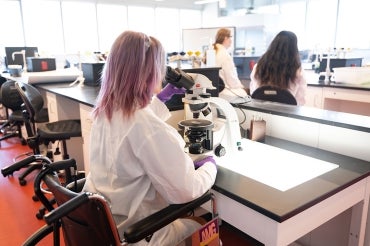Second National Dialogues and Action draws experts on accessibility, ableism and inclusion from across Canada

Published: December 9, 2022
Cassandra Hartblay recalls a time in graduate school when a senior scholar in her field wasn’t able to give feedback on a research presentation she gave at an academic conference.
The scholar, it turned out, missed the session because a requested accommodation wasn’t available.
Not being able to receive feedback from a prominent scholar in her field was a stark reminder for Hartblay that failing to meet even basic standards of accessibility can interrupt teaching and learning on many levels — from the impact on the expert who has a disability, to the people who are deprived of their expertise.
“It was true for me as a disabilities studies researcher, but it may be true for someone working in a science lab that also isn’t accessible,” said Hartblay, an assistant professor and director of the Centre for Global Disability Studies at U of T Scarborough.
“When someone's access needs aren't being met, they're not able to get feedback to junior colleagues and students. It can affect the whole academic community.”
Looking at barriers to learning and working in the post-secondary sector was just one of several topics covered during the second National Dialogues and Action. The day-long virtual event brought together nearly 1,000 participants from across Canadian higher education and experts from outside the sector.
Conversations held during this year’s event focused on addressing structural ableism, developing inclusive curricula, learning design, work facilitation, and research supports, as well as inclusive infrastructure, design, and planning.
The consequences of not creating more accessible and inclusive post-secondary campuses couldn’t be starker, said Jay Dolmage, associate professor at University of Waterloo.
While 24 per cent of first-year university students self-declare as having a disability, only six to nine per cent of those students seek accommodation. The result is that fewer students with disabilities are finishing their degrees. He said while 27 per cent of Canadians have university degrees, only 17.6 per cent of Canadians with disabilities have one.
The problem is not specific to students. Only 42 per cent of Canadian universities have a written accommodation policy for faculty, Dolmage said.
“We do not have a system that's sustainable for disabled students, staff or faculty,” he said. “The only thing for certain is that if we continue doing things the way that we've been doing them, then we'll continue to lose disabled staff, faculty and students.”
Those in attendance argued that for education to become more inclusive, it may require larger structural changes.
Olga Dosis, a professor at George Brown College, said while a lot of work has been done on accessibility, there continue to be systemic barriers to full inclusion across Canadian post-secondary institutions. For example, she said that accommodations are a kind of “retrofit solution” that attempt to fit students into a system that isn’t inclusive to begin with. Another major hurdle is that accessibility policies and practices differ from one institution to the next.
“Over time we’ve normalized ableist attitudes within our institutions,” she said, alluding to the fact that barriers are often left to individual students to overcome on their own.
Even attempting to adopt universal design principles can be a major challenge for post-secondary institutions given their size, said Frederic Fovet, an assistant professor at Thompson Rivers University.
He said while there is a lot of research on the benefits of universal design, there is very little research on how to implement it, especially at large bureaucratic institutions that can be slow to change.
The afternoon sessions included conversations about inclusive infrastructure and design, which includes physical and virtual spaces on campus, and how equity, diversity and inclusion (EDI) researchers can collaborate more often with accessibility researchers.
Mahadeo Sukhai, vice-president of research and international affairs and chief accessibility officer for CNIB, urged those in attendance to adopt an accessible procurement policy if they haven’t already, especially for learning management systems. He added that these systems also need to be tested rigorously by staff and faculty with expertise before being rolled out to students.
Technology has also evolved in recent years to become a powerful accessibility tool, said Catherine Fichten, an associate professor in the department of psychiatry at McGill University.

She singled out recent developments in AI-based software such as video captioning software, voice activation technology, improved computer and mobile phone operating systems as being very beneficial for students, faculty and staff with disabilities. Despite the advancements, she noted barriers remain such as the high cost of software and availability of accessible textbooks, and the design of academic evaluations and inaccessible documents, to name a few. And most importantly, she said people with disabilities need to be involved in training AI systems.
This was the second National Dialogues hosted by the University of Toronto Scarborough. The first one, held in 2020, explored anti-Black racism and promoting Black inclusion and resulted in the co-creation of the Scarborough Charter.
The organizers plan to publish a report in 2023 detailing the conversations that took place during this year’s National Dialogues, which will help institutions chart a path forward in addressing ableism and inclusivity on their own campuses.



